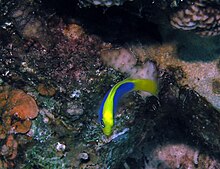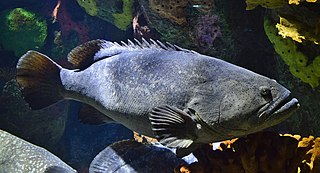
The giant grouper, also known as the Queensland grouper, brindle grouper or mottled-brown sea bass, is a species of marine ray-finned fish, a grouper from the subfamily Epinephelinae which is part of the family Serranidae, which also includes the anthias and sea basses. It has a wide Indo-Pacific distribution and is one of the largest extant species of bony fish.

The dottybacks are a family, Pseudochromidae, of fishes which were formerly classified in the order Perciformes, but this has been revised and the family is regarded as of uncertain affinities, or incertae sedis within the Ovalentaria, a clade within the Percomorpha. Around 152 species belong to this family.
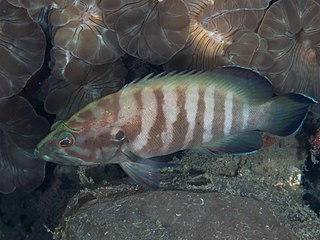
Cephalopholis boenak, the chocolate hind, brownbarred rockcod, brown-banded cod or brown-banded rockcod, is a species of marine ray-finned fish, a grouper from the subfamily Epinephelinae which is in the family Serranidae which also includes the anthias and sea basses. It is associated with reefs over a wide Indo-Pacific distribution. It is an important species for commercial fisheries in some parts of its range.

The orange-spotted grouper, also known as the brown-spotted rockcod, estuary cod, estuary rockcod, goldspotted rockcod, greasy cod, North-west groper, orange spotted cod or blue-and-yellow grouper, is a species of marine ray-finned fish, a grouper from the subfamily Epinephelinae which is part of the family Serranidae, which also includes the anthias and sea basses. It has an Indo-Pacific distribution and is found in marine and brackish waters.

The potato grouper, also called the potato cod or potato bass, is a species of marine ray-finned fish, a grouper from the subfamily Epinephelinae which is part of the family Serranidae, which also includes the anthias and sea basses. It has a wide Indo-Pacific distribution.
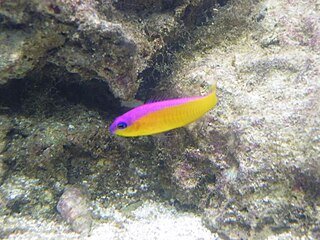
Pictichromis diadema, the bicolor dottyback, diadem dottyback, or purple-top dottyback is a fish species of the dottyback family. It is a popular aquarium fish species.
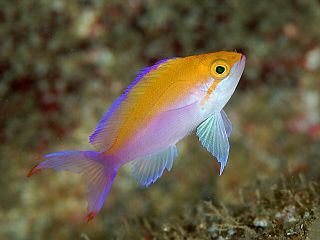
Pseudanthias bicolor, the bicolor anthias or yellowback basslet is a species of marine ray-finned fish from the subfamily Anthiinae of the family Serranidae, the groupers and sea basses. It is from the Indo-Pacific Ocean. It occasionally makes its way into the aquarium trade. It grows to a size of 13 cm in length.

Congrogadinae is a subfamily of ray-finned fishes, one of four subfamilies that make up the family Pseudochromidae, these elongated fish are commonly called eel-blennies.

Congrogadus is a genus of ray-finned fishes, the type genus of the subfamily Congrogadinae, the eel blennies, part of the dottyback family, Pseudochromidae. The genus Congrogadus has an Indo-Pacific distribution.
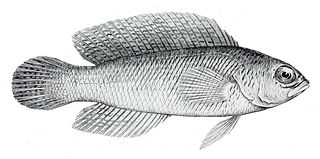
Cypho is a genus of ray-finned fishes from the subfamily Pseudochrominae, which is one of four subfamilies in the dottyback family Pseudochromidae. They are found in the tropical western Pacific Ocean as far east as Tonga.

Manonichthys is a genus of ray-finned fishes from the subfamily Pseudochrominae, which is one of four subfamilies in the dottyback family Pseudochromidae. They are found in the tropical eastern Indian Ocean and the western Pacific Ocean. Many of the species of Manonichthys live within the bodies of large sponges, the genus name references the Greek word for a kind of sponge, manon, in combination with the Greek word for "fish", ichthys.
Pholidochromis is a genus of ray-finned fishes from the subfamily Pseudochrominae, which is one of four subfamilies in the dottyback family Pseudochromidae. They occur in the western and central Pacific Ocean.

Pictichromis is a genus of ray-finned fishes from the subfamily Pseudochrominae, which is one of four subfamilies in the dottyback family Pseudochromidae. They occur in the western and central Pacific Ocean.
Pseudoplesiopinae is a subfamily of the family Pseudochromidae, the dottybacks, it consists of small species of coral-reef inhabiting fish which are distributed throughout the Indo-Pacific.
Pectinochromis is a monospecific genus of ray-finned fish from the subfamily Pseudoplesiopinae in the family Pseudochromidae, the dottybacks. The only species in the genus is Pectinochromis lubbocki, a small reef living dottyback from the Red Sea. This genus is the sister taxon to the genus Chlidichthys. The specific name honours the Cambridge University ichthyologist Roger Lubbock (1951–1981), in recognition of his work on the taxonomy of the subfamily Pseudoplesiopinae.
Pseudochromis aureolineatus, the gold-lined dottyback, is a species of ray-finned fish from the Comores and Indonesia in the Indian Ocean, which is a member of the family Pseudochromidae. This species reaches a length of 7.1 cm (2.8 in).
Pseudochromis kristinae, the lip-stick dottyback, is a species of ray-finned fish from the Western Indian Ocean: along East Africa, around the island of Madagascar and the Comoro Islands, which is a member of the family Pseudochromidae. This species reaches a length of 4.6 cm (1.8 in).
Pseudochromis madagascariensis, the Madagascan dottyback, is a species of ray-finned fish from Madagascar, which is a member of the family Pseudochromidae. This species reaches a length of 5.2 cm (2.0 in).
Pseudochromis melanurus, the black-tail dottyback, is a species of ray-finned fish from Tonga and Fiji in the Pacific Ocean, which is a member of the family Pseudochromidae. This species reaches a length of 4.0 cm (1.6 in).
Pseudochromis mooii, the Mooi's dottyback, is a species of ray-finned fish from Indonesia, which is a member of the family Pseudochromidae. This species reaches a length of 4.9 cm (1.9 in).
